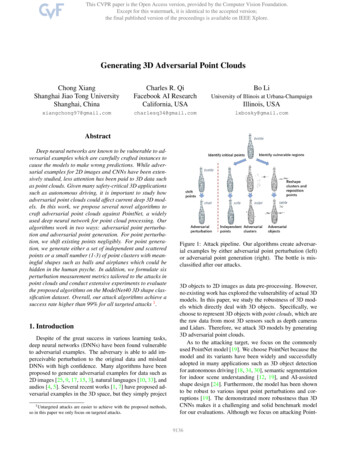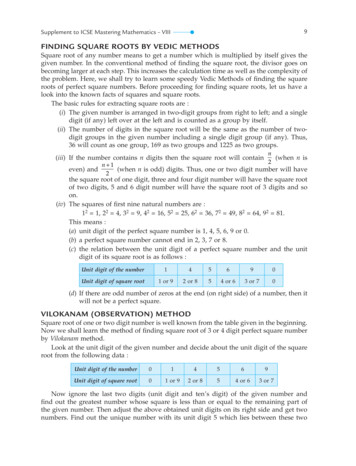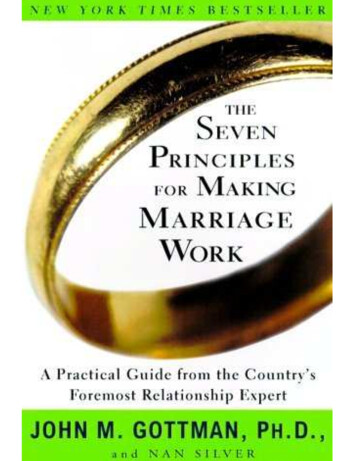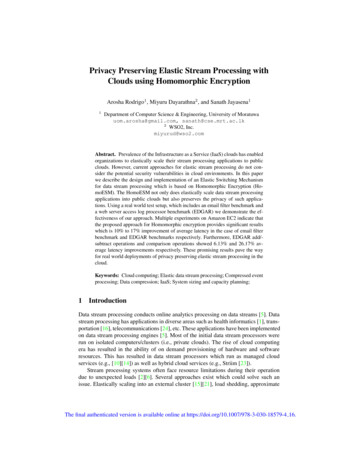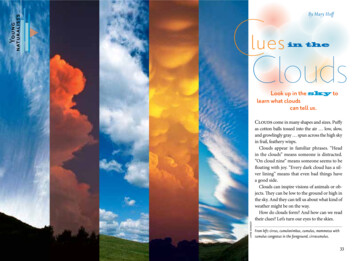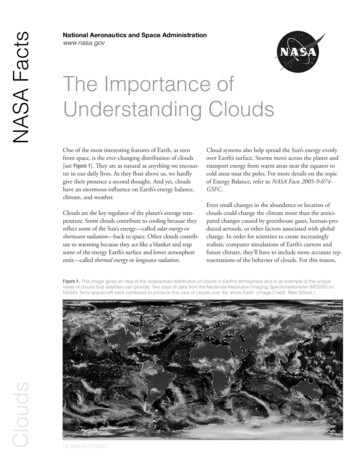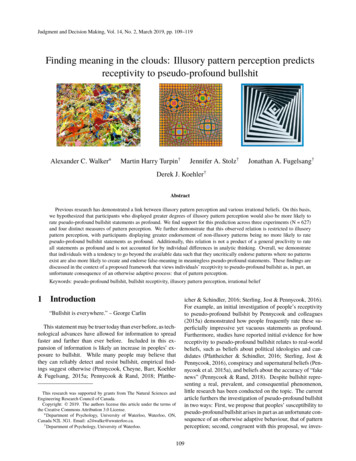
Transcription
Judgment and Decision Making, Vol. 14, No. 2, March 2019, pp. 109–119Finding meaning in the clouds: Illusory pattern perception predictsreceptivity to pseudo-profound bullshitAlexander C. Walker Martin Harry Turpin†Jennifer A. Stolz†Jonathan A. Fugelsang†Derek J. Koehler†AbstractPrevious research has demonstrated a link between illusory pattern perception and various irrational beliefs. On this basis,we hypothesized that participants who displayed greater degrees of illusory pattern perception would also be more likely torate pseudo-profound bullshit statements as profound. We find support for this prediction across three experiments (N 627)and four distinct measures of pattern perception. We further demonstrate that this observed relation is restricted to illusorypattern perception, with participants displaying greater endorsement of non-illusory patterns being no more likely to ratepseudo-profound bullshit statements as profound. Additionally, this relation is not a product of a general proclivity to rateall statements as profound and is not accounted for by individual differences in analytic thinking. Overall, we demonstratethat individuals with a tendency to go beyond the available data such that they uncritically endorse patterns where no patternsexist are also more likely to create and endorse false-meaning in meaningless pseudo-profound statements. These findings arediscussed in the context of a proposed framework that views individuals’ receptivity to pseudo-profound bullshit as, in part, anunfortunate consequence of an otherwise adaptive process: that of pattern perception.Keywords: pseudo-profound bullshit, bullshit receptivity, illusory pattern perception, irrational belief1 Introduction“Bullshit is everywhere.” – George CarlinThis statement may be truer today than ever before, as technological advances have allowed for information to spreadfaster and farther than ever before. Included in this expansion of information is likely an increase in peoples’ exposure to bullshit. While many people may believe thatthey can reliably detect and resist bullshit, empirical findings suggest otherwise (Pennycook, Cheyne, Barr, Koehler& Fugelsang, 2015a; Pennycook & Rand, 2018; PfattheThis research was supported by grants from The Natural Sciences andEngineering Research Council of Canada.Copyright: 2019. The authors license this article under the terms ofthe Creative Commons Attribution 3.0 License. Department of Psychology, University of Waterloo, Waterloo, ON,Canada N2L 3G1. Email: a24walke@uwaterloo.ca.† Department of Psychology, University of Waterloo.icher & Schindler, 2016; Sterling, Jost & Pennycook, 2016).For example, an initial investigation of people’s receptivityto pseudo-profound bullshit by Pennycook and colleagues(2015a) demonstrated how people frequently rate these superficially impressive yet vacuous statements as profound.Furthermore, studies have reported initial evidence for howreceptivity to pseudo-profound bullshit relates to real-worldbeliefs, such as beliefs about political ideologies and candidates (Pfattheicher & Schindler, 2016; Sterling, Jost &Pennycook, 2016), conspiracy and supernatural beliefs (Pennycook et al. 2015a), and beliefs about the accuracy of “fakenews” (Pennycook & Rand, 2018). Despite bullshit representing a real, prevalent, and consequential phenomenon,little research has been conducted on the topic. The currentarticle furthers the investigation of pseudo-profound bullshitin two ways: First, we propose that peoples’ susceptibility topseudo-profound bullshit arises in part as an unfortunate consequence of an otherwise adaptive behaviour, that of patternperception; second, congruent with this proposal, we inves-109
Judgment and Decision Making, Vol. 14, No. 2, March 2019tigate whether individuals susceptible to endorsing illusorypatterns are more receptive to pseudo-profound bullshit.1.1Pseudo-profound bullshitInitial investigations of bullshit, specifically of the pseudoprofound variety, have utilized Frankfurt’s (2005) conception of bullshit as an absence of concern for the truth. Thatis, according to Frankfurt, bullshit is not about falsity butrather fakery; bullshit may be true, false, or meaningless,what makes a claim bullshit is an implied yet artificial attention to the truth. Consistent with this description of bullshit,Pennycook and colleagues (2015a) generated a list of superficially impressive statements that implied yet did not containeither truth or meaning by having a computer program randomly arrange a set of profound-sounding words in a waythat maintained proper syntactic structure (see Dalton, 2016,for a comment, and Pennycook, Cheyne, Barr, Koehler &Fugelsang, 2016, for a response).In addition to demonstrating peoples’ receptiveness tomeaningless pseudo-profound bullshit statements, Pennycook and colleagues (2015a) revealed how various individualdifferences were associated with bullshit receptivity. Specifically, it was found that those more receptive to bullshit wereless analytic thinkers (e.g., scored lower on the CognitiveReflection Test), scored lower in measures of cognitive ability (e.g., the Wordsum test and Raven’s Advanced Progressive Matrices), and were more likely to hold religious, conspiratorial, and paranormal beliefs. Two mechanisms wereproposed to explain participants’ endorsement of pseudoprofound bullshit. First, some participants were shown topossess a general tendency to afford any and all statementssome level of profundity (e.g., mundane statements suchas “Some things have very distinct smells”). The results ofPennycook and colleagues suggest that this gullible tendencytowards ascribing profoundness to even the most mundane ofstatements is one component of bullshit receptivity. Second,individual differences in analytic thinking (as measured bythe Cognitive Reflection Test and a “Heuristics and Biases”battery) were found to be associated with bullshit receptivity. Specifically, those with a propensity for analytic (asopposed to intuitive) thinking were found to be less receptiveto pseudo-profound bullshit. Thus, another explanation putforth by Pennycook and colleagues is that individuals differ with regards to their ability to detect bullshit, with moreanalytic thinkers being more likely to detect and criticallyreflect on the presented pseudo-profound bullshit statementsleading to lower ratings of profundity. The primary goalof this paper is to propose a third compatible mechanismto explain individual differences in receptivity to pseudoprofound bullshit: the illusory perception of patterns.Illusory pattern perception and bullshit detection1.2110Illusory pattern perceptionThe ability to perceive patterns and form meaningful connections between stimuli in our environment is clearly evolutionarily advantageous (Beck & Forstmeier, 2007; Mattson,2014; Shermer, 2011). For example, Mattson (2014) claimsthat superior pattern processing capabilities are essential fora variety of higher cognitive functions (e.g., imagination andinvention) and likewise, credits these capabilities as fundamental to the technological progress humans have enjoyed.Relatedly, he argues that evolved superior pattern processingabilities are a primary reason why human cognition greatlyexceeds the capabilities of lower species. Due to the adaptive nature of pattern perception, it has been claimed thatwe are the descendants of those best able to detect patterns(Shermer, 2011).Nevertheless, our proclivity for detecting patterns comeswith a cost, as we often find it difficult to distinguish between real and illusory patterns. Therefore, the same adaptive processes that allow us to perceive patterns and identifymeaningful connections between stimuli in our environmentalso leads us to sometimes perceive illusory patterns andconsequently endorse false beliefs about reality. However,when comparing the consequences of failing to detect a realand informative pattern with those of endorsing an illusorypattern, one of these errors may frequently loom larger thanthe other. For example, failing to connect a rustling in thegrass with the presence of a dangerous predator has moredire consequences than mistakenly attributing movement inthe grass to a predator and misguidedly escaping from agust of wind. Using an evolutionary model, Biologist Fosterand Kokko (2009) demonstrated how natural selection canfavour strategies that involve the frequent endorsement ofillusory patterns in order to ensure successful detection ofmeaningful patterns that offer large reproductive and survivalbenefits. Additionally, beliefs based on illusory patterns caneven be advantageous if they disrupt aversive feelings, suchas overwhelming thoughts of lacking control in an unpredictable world (Hogg, Adelman & Blagg, 2010; Whitson &Galinsky, 2008). This asymmetry of consequences betweenmissing a real pattern and endorsing an illusory one is onereason humans are said to have evolved a “believing-brain”with a proclivity for pattern perception and a susceptibility to being fooled by illusory patterns (Beck & Forstmeier,2007; Foster & Kokko, 2009; Shermer, 2011). Thus, not unlike the adaptive heuristics that guide decision-making, yetpredictably lead to certain biases, pattern perception mayrepresent an adaptive function at the heart of both rationaland irrational beliefs about how stimuli are connected in theenvironments that we inhabit.Illusory pattern perception includes the perception of connections between unrelated stimuli as well as the perceptionof patterns within random stimuli. One reason for the occurrence of illusory pattern perception is the fact that individ-
Judgment and Decision Making, Vol. 14, No. 2, March 2019uals often have difficulty accepting that ordered events canemerge from random processes. For example, when asked toproduce random sequences, people often produce far morevariation (and therefore fewer “runs”) than would be createdby a truly random process (Falk & Konold, 1997). Whatfollows, is that when people encounter random sequencesthat coincidentally maintain some order (e.g., symmetry ina series of coin tosses) they may ascribe a meaningful nonrandom process as its source (Gilovich, Vallone & Tversky,1985).People’s tendency to engage in illusory pattern perceptionhas been shown to be associated with various irrational beliefs (Blackmore & Moore, 1994; Van Harreveld, Rutjens,Schneider, Nohlen & Keskinis, 2014; Van Prooijen, Douglas& Inocencio, 2018; Wiseman & Watt, 2006). For example,Van Prooijen, Douglas and Inocencio (2018), found that individuals who perceive more illusory patterns are also morelikely to endorse conspiracy and supernatural beliefs. Related to this association between illusory pattern perceptionand irrational belief is the finding that lacking control increases illusory pattern perception (Van Harreveld et al.,2014; Whitson & Galinsky, 2008). Whitson and Galinsky (2008) demonstrate that those induced to feel a lack ofcontrol perceive more illusory patterns and engage in moreconspiratorial and superstitious thinking. On the basis ofthis evidence they argue that feeling a lack of control inone’s environment is so aversive that individuals will oftenendorse illusory patterns and irrational beliefs in order todiminish feelings of lacking control and return to the morepleasant view that one’s environment is predictable. Consistent with this argument is additional evidence demonstratingthat lacking control increases conspiracy (Sullivan, Landau& Rothschild, 2010; Van Prooijen & Acker, 2015) and supernatural beliefs (Kay, Gaucher, McGregor & Nash, 2010;Laurin, Kay & Moscovitch, 2008). Therefore, irrational beliefs may not only arise as the result of a believing-brain witha proclivity towards pattern perception, but also as a compensatory strategy that seeks to endorse patterns (illusory ornot) in order to alleviate aversive states, such as feeling alack of control in an unpredictable environment.1.3The current studyThe current study investigates how individual differences inpattern perception relate to differences in pseudo-profoundbullshit receptivity. While previous studies have observeda positive relation between illusory pattern perception andvarious irrational beliefs (e.g., conspiracy and supernaturalbeliefs; Van Harreveld et al., 2014; Van Prooijen et al., 2018)no study has examined the relation between pattern perception and bullshit receptivity. Bullshit is distinct from otherirrational beliefs on two dimensions. First, bullshit as conceived of by Frankfurt (2005) is disinterested in the specifictruth or untruth of a given claim. That is, the primary goalIllusory pattern perception and bullshit detection111of a bullshitter is to be persuasive, without concern for thevalidity of their claims. In contrast, irrational beliefs involveindividuals endorsing beliefs that are specifically concernedwith making truth claims. For example, the belief that theUnited States government is covering up its own involvementin the 2001 Islamic terrorist attacks against the World TradeCentre. In this case, those with a belief in this conspiracyare insisting that there is a truth to be discovered that ismerely being covered up by a government’s deception. Thispoint leads into a second distinguishing feature of bullshit:specificity. Continuing with the example of the 911 attacks,endorsing this belief comes along with endorsing a specificset of rules for how the world and governments operate. Bullshit receptivity, however, requires only the vague perceptionthat there is something meaningful being communicated bythe bullshitter. Bullshit receptivity could be an early contributor to the eventual adoption of an irrational belief, butthere is no reason a priori to assume that they are identical.Despite being distinguished from other irrational beliefs,we expect that bullshit receptivity will relate to illusory pattern perception in a familiar way. Specifically, we hypothesize that individuals susceptible to endorsing illusory patterns will be more receptive to pseudo-profound bullshit.This hypothesis is consistent with our view of receptivity topseudo-profound bullshit as arising in part as an unfortunateconsequence of an otherwise adaptive process: the uncritical perception of patterns in our environment. Therefore, webelieve that individuals with a greater tendency to go beyondthe available data and uncritically endorse patterns where nopatterns exist will also be more likely to create and endorsefalse-meaning in meaningless pseudo-profound statements.Importantly, we expect this relation to remain after controlling for individual differences in analytic thinking. Controlling for analytic thinking is important as individual differences in analytic thinking have been shown to relate toa host of irrational beliefs, including conspiracy and supernatural thinking (Pennycook, Fugelsang & Koehler, 2015b;Shenhav, Rand & Greene, 2012; Swami, Voracek, Stieger,Tran, & Furnham, 2014). Therefore, it is possible that previous positive associations observed between illusory patternperception and various irrational beliefs are simply a resultof those with an intuitive (as opposed to analytic) thinkingstyle being more likely to endorse illusory patterns as wellas irrational beliefs. Lastly, we expect illusory pattern perception to share an association with bullshit sensitivity, ameasure of participants’ ability to distinguish between legitimately meaningful motivational quotations and pseudoprofound bullshit statements. That is, we believe that individual differences in illusory pattern perception will relatespecifically to the endorsement of meaningless statements asprofound as opposed to relating to an increase in profundityratings in general.In Experiments 1 and 2 we build on two experiments fromVan Prooijen and colleagues (2018), which examined the
Judgment and Decision Making, Vol. 14, No. 2, March 2019relation between participants’ endorsements of illusory patterns and their level of conspiracy and supernatural belief.Importantly, we modified these experiments in order to assessthe research questions at hand by replacing items assessingparticipants’ conspiracy and supernatural beliefs with a profundity judgment task featuring both pseudo-profound bullshit statements and motivational quotations. Furthermore,we added in a measure of analytic thinking in order to assessand control for individual differences in thinking style. InExperiment 3 we improve upon these first two experimentsby utilizing two new measures of pattern perception whichmore concretely and objectively feature both real and illusory patterns. These measures of pattern perception allowus to more convincingly distinguish between how individualdifferences in illusory, as opposed to non-illusory, patternperception relate to differences in bullshit receptivity andbullshit sensitivity. Taken together, the current study utilizesfour distinct measures of pattern perception to conduct aninitial investigation of how individual differences in the endorsement of both illusory and non-illusory (Experiments 2and 3) patterns predicts individuals’ receptivity to pseudoprofound bullshit.2 Study 12.1Method2.1.1ParticipantsA sample of 201 participants were recruited from Amazon Mechanical Turk and received 2.00 upon completionof a 15-minute online questionnaire. Across all three experiments, participants were recruited under the conditionthat they be U.S. residents and possess a Mechanical TurkHIT approval rate greater than or equal to 95%. All experiments reported in the current study were preregisteredthrough Open Science Framework.12.1.2MeasuresPattern perception. To assess participants’ degree of illusory pattern perception we employed a pattern perception measure used by Van Prooijen and colleagues (2018).Specifically, this measure indexes the degree to which participants find it difficult to accept that ordered or partiallyordered sequences can arise from random processes. In thistask, participants rated the extent to which they felt that1We preregistered all methods, hypotheses, and analyses for eachof our three experiments through Open Science Framework: Registration forms for all three reported experiments can be viewed byfollowing the links below (Experiment 1: https://osf.io/rxtn9/?viewonly a1a69426948e4df8b67f7ce48fe21e36, Experiment 2: https://osf.io/fpr32/?view only 8f1a964fa76e4a8ca574d71292ae5ca0, Experiment 3:https://osf.io/x9vue/?view only 36854c9508d3428ab31d816a7fd5ce92).Illusory pattern perception and bullshit detection112randomly generated coin flip sequences were random or predetermined on a 7-point scale (1 completely random, 7 completely determined). A total of 11 pattern perceptionitems were presented to participants. The first ten itemsfeatured unique ten-flip coin sequences (e.g., HTHHTTTTHH), whereas the final item presented all previously seensequences together and asked participants to rate the randomness of the 100 coin flip sequence. Overall, responses givento all 11 items were averaged to form an 11-item pattern perception score. A full list of items (for all measures reportedin the current study) can be viewed in the supplementarymaterials.Bullshit Receptivity Scale. The Bullshit Receptivity(BSR) scale, taken from Pennycook and colleagues (2015a),was administered to participants in Experiment 1. This scaleconsists of ten pseudo-profound bullshit statements originally obtained from two websites (http://wisdomofchopra.com and http://sebpearce.com/bullshit/) able to create meaningless statements by randomly arranging a list of profoundsounding words together in a way that retains syntactic structure. Participants rated the profundity of each statementusing a 5-point scale (1 Not at all profound, 5 Very profound). A BSR score for each participant was calculated byaveraging the profundity ratings given to the ten presentedpseudo-profound bullshit statements.Motivational Quotation Scale. To contrast the meaningless statements featured in the BSR, the motivational quotation scale, originating from Pennycook and colleagues(2015a), was administered to participants. This scale consisted of ten motivational quotations originally obtained viaan internet search. Importantly, unlike the statements featured in the BSR, these ten statements were constructed witha clear intention of meaning. Thus, unlike the presentedBSR statements, these statements were intended to represent“truly” meaningful statements for which the majority of people could reasonably endorse as profound. Participants ratedthe profundity of each motivational statement using the same5-point scale used to assess BSR items. Likewise, participants’ profundity ratings to the ten presented motivationalquotations were averaged to create a motivational quotationscale score for each participant.Bullshit sensitivity. Bullshit sensitivity is a measure of aparticipant’s ability to distinguish pseudo-profound bullshitfrom meaningfully profound motivational quotations (Pennycook et al., 2015a). Bullshit sensitivity was computed bysubtracting participants’ mean profundity ratings given tomotivational quotations from their mean profundity ratingsgiven to pseudo-profound bullshit statements. Higher scoresindicate less sensitivity in detecting bullshit.
Judgment and Decision Making, Vol. 14, No. 2, March 2019Illusory pattern perception and bullshit detection113Table 1: Experiment 1 Correlations. (Cronbach’s alphas in parentheses.)M1.2.3.4.5.Pattern Perception3.20BSR2.31Motivational quotations3.13CRT1.84BS Sensitivity (Var2 Var3) 0.82SD1.160.970.831.470.911234(.86).35 (.93).17 .49 (.87) .23 .37 .18 (.72).21 .61 .39 .22 5 Note. Pearson correlations (Experiment 1; N 201). BSR Bullshit Receptivity scale; CRT Cognitive Reflection Test. BS Sensitivity Participants’ mean BSR profundity ratings minus theirmean motivational quotation profundity ratings. p .001, p .01, p .05.Cognitive Reflection Test. The Cognitive Reflection Test(CRT; Frederick, 2005) was designed to evaluate individuals’ability to suppress an intuitive incorrect response in favourof a deliberative correct answer. Participants were presentedwith four CRT items taken from Toplak, West and Stanovich,(2014) and Primi, Morsanyi, Chiesi, Donati and Hamilton(2016). The number of correct responses was summed foreach participant, giving each participant a CRT score thatranged from zero to four.Participants completed an online questionnaire in which theycompleted all four measures described above. Specifically,participants began by completing eleven pattern perceptionitems. Next, participants were asked to rate the profundityof twenty statements (BSR and motivational quotations) thatwere presented in a randomized order. Finally, participantscompleted a nine-item belief in existing conspiracy theoriesscale2 and responded to four CRT items.and illusory pattern perception (r(187) .21, p .001), indicating that illusory pattern perception did not simply relateto a tendency to find profoundness in all things unselectively. Rather, illusory pattern perception was associatedwith participants’ ability to distinguish between meaningfulmotivational quotations and pseudo-profound bullshit statements. Furthermore, replicating the results of past research(Pennycook et al., 2015a; Pennycook & Rand, 2018), participant’s CRT scores correlated negatively with BSR scores(r(197) .37, p .001). Notably, a partial correlationshowed that the relation between illusory pattern perceptionand bullshit receptivity was largely unaffected after including participant’s CRT performance as a covariate (r(190) .30, p .004, vs. r .35 without the covariate), indicatingthat individual differences in CRT performance did not account for the association between illusory pattern perceptionand bullshit receptivity. This was also true of the relationbetween bullshit sensitivity and illusory pattern perception(r(186) .17, p .020, vs. r .21 without the covariate),when including CRT performance as a covariate.2.23 Study 22.1.3ProcedureResults and discussionThe results of Experiment 1 are shown in Table 1. As expected, illusory pattern perception was positively correlatedwith participants’ BSR scores (r(191) .35, p .001). Thatis, participants who rated randomly generated coin toss sequences as more determined were also more likely to rateBSR items as profound. A weaker relation was observedbetween illusory pattern perception and motivational quotations (r(189) .17, p .020), demonstrating that illusorypattern perception also shared a positive association withprofundity ratings for meaningful statements. Nevertheless,a positive relation was observed between bullshit sensitivity(the difference between BSR and motivational quotations)2This scale, presented exclusively in Experiment 1, was included forreasons peripheral to the main objective of the current study and thereforewill not be discussed further in the main body of this manuscript. However,see our supplementary materials for a set of analyses featuring this scale.The results of Experiment 1 support our hypothesis that illusory pattern perception is positively associated with bullshitreceptivity. The primary goal of Experiment 2 was to buildon this finding by discriminating between two accounts forthis association. First, a positive association between illusorypattern perception and bullshit receptivity may be a result ofa general tendency towards perceiving patterns, whether realor illusory, being predictive of greater bullshit receptivity. Incontrast, it may be exclusively a tendency towards illusorypattern perception that predicts greater bullshit receptivity.Previous research investigating the relation between nonillusory pattern perception and conspiracy and supernatural beliefs demonstrated that non-illusory pattern perceptionwas uncorrelated with conspiracy beliefs and negatively correlated with supernatural beliefs (Van Prooijen, et al., 2018).In order to discriminate between these two accounts, Ex-
Judgment and Decision Making, Vol. 14, No. 2, March 2019Illusory pattern perception and bullshit detection114Table 2: Experiment 2 Correlations. (Cronbach’s alphas in parentheses.)M1.2.3.4.5.6.Chaotic Art Pattern Perception2.74Structured Art Pattern Perception6.09BSR2.33Motivational quotations3.22CRT1.59BS Sensitivity (Var3 Var4) 0.89SD121.270.850.900.781.330.90(.90) .30 .14 .08.17(.89) .23 .02.16 .24 345(.91).43 (.84) .26 .17 (.62) .62 .44 .116 Note. Pearson correlations (Experiment 2; N 200). BSR Bullshit Receptivity scale; CRT Cognitive ReflectionTest. BS Sensitivity Participants’ mean BSR profundity ratings minus their mean motivational quotation profundityratings. p .001, p .01, p .05.periment 2 had participants randomly assigned to evaluatepaintings in which the appearance of a meaningful patternwas either present (structured paintings) or absent (chaoticpaintings). On the basis of past findings, we hypothesizedthat perceiving patterns in chaotic, but not structured paintings, would be positively associated with bullshit receptivity.sessed by asking participants “To what extent do you see apattern in this painting?” for which they responded using a7-point scale ranging from 1 (not at all) to 7 (very much).Following this initial portion of the experiment participantsrated the profundity of 20 statements and completed the fourCRT items used in Experiment 1.3.1Method3.2Results and discussion3.1.1Participants3.2.1ParticipantsA sample of 220 participants were recruited from AmazonMechanical Turk and received 2.00 upon completion of a15-minute online questionnaire. Those who participated inExperiment 1 were not recruited for Experiment 2.3.1.2In Experiment 2 we removed all participants whose responses contained missing data. This intention was registered prior to data collection and analysis. Following thisrule, we removed 20 participants thus leaving us with ourtarget sample size of 200 participants.Measures and ProcedureIn order to assess pattern perception in Experiment 2, weemployed items used by Van Prooijen and colleagues (2018)which had participants rate the extent to which they saw a pattern in various modern art paintings. Participants randomlyassigned to the chaotic art condition were asked to evaluatenine paintings by US artist Jackson Pollock whereas thoseassigned to the structured art condition evaluated nine paintings by Hungarian artist Victor Vasarely (see supplementarymaterials; examples are also shown under the title). Although participants were not informed of the artist’s name ineither condition, they were informed that the paintings theywould be evaluating all came from the same artist. Furthermore, in the chaotic art condition, participants were informedthat they would be presented with paintings from an artist“well known for his random brush strokes and irregular figures.” Similarly, in the structured art condition, participantswere informed that the artist whose paintings they wouldbe evaluating was “well-known for his regular design andalignment of figures.” Each painting was presented alongwith three questions regarding beauty, familiarity, and pattern perception. Most notably, pattern perception was as-3.2.2Main findingsThe results of Experiment 2 are shown in Table 2. As expected, perceiving patterns in chaotic art was positively associated with bullshit receptivity (r(95) .30, p .003).No such association was found between chaotic art pattern perception and profundity ratings for motivational quotations (r(95) .14, p .182), suggesting a dissociationbetween how individual differences in illusory pattern perception relate to profundity judgments given to meaningful and pseudo-profound statements. However, no significant relation was observed between bullshit sensitivity andthe perception of patterns in chaotic art (r(95) .17, p .089), indicating that the t
predictably lead to certain biases, pattern perception may represent an adaptive function at the heart of both rational . and irrational belief is the finding that lacking control in-creases illusory pattern perception (Van Harreveld et al., 2014; Whitson & Galinsky, 2008). Whitson and Galin-

